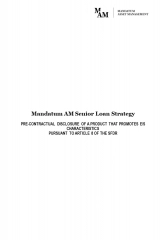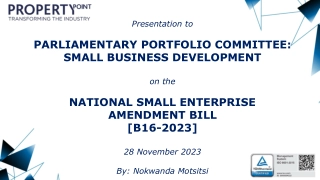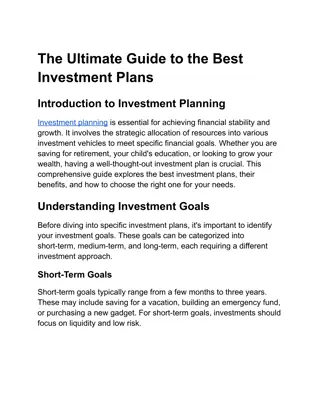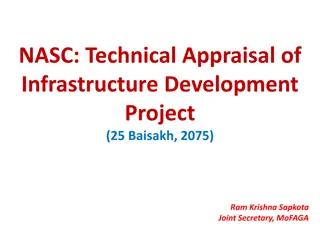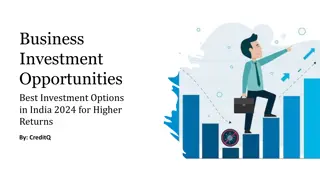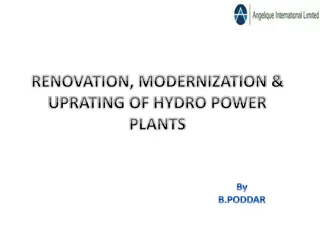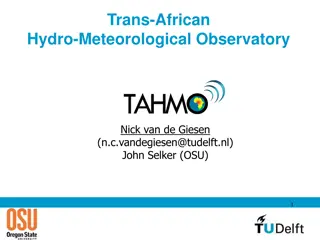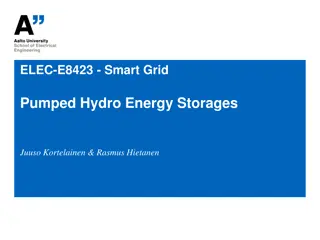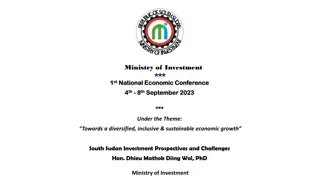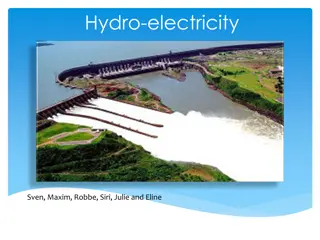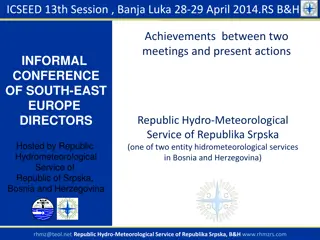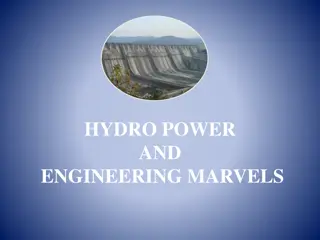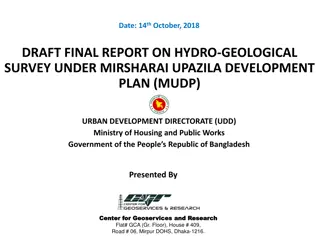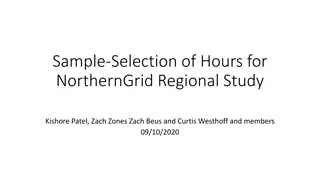Challenges and Opportunities in Small Hydro Development: Discussion on Innovative Investment Models
This discussion covers the challenges and opportunities in small hydro development, including license and investment status, impact of COVID-19, recommendations for relief, and future development and financial models. It highlights the status of licenses for projects up to 5MW, investment information, and pre-COVID-19 baseline data on operating projects, shedding light on the issues faced by the sector.
Download Presentation

Please find below an Image/Link to download the presentation.
The content on the website is provided AS IS for your information and personal use only. It may not be sold, licensed, or shared on other websites without obtaining consent from the author.If you encounter any issues during the download, it is possible that the publisher has removed the file from their server.
You are allowed to download the files provided on this website for personal or commercial use, subject to the condition that they are used lawfully. All files are the property of their respective owners.
The content on the website is provided AS IS for your information and personal use only. It may not be sold, licensed, or shared on other websites without obtaining consent from the author.
E N D
Presentation Transcript
Challenges and Opportunities in Small Hydro Development & Discussion on Innovative Development & Investment/Financing Model Er. Surya Prasad Adhikari Executive Chairman Barahi Hydropower Public Limited
Contents 1. Background 1.1 License Status 1.2 Investment Status 1.3 Baseline of IPPs Operating Projects before COVID 2. Impact of COVID-19 pandemic. 2.1 Sales/Generation; Income ; Safety of Project Structures 4. Recommendations for immediate relief 5. Way Forward: 4.1 Development Model 4.2 Financial Model
1.1 License Status (upto 5 MW) Survey License Applied Below 1 MW Upto 3 MW Upto 5 MW Survey License Received Below 1 MW Above 1 to 3 MW 7 Projects / 16.35 MW Above 1 to 5 MW 23 Projects / 83.939 MW Generation License Applied Below 1 MW Upto 3 MW Upto 5 MW Generation License Received Below 1 MW Upto 3 MW Upto 5 MW 1 project/0.67 MW 1 project/0.67 MW 3 projects / 12 MW Operating Projects - Below 1 MW 15 /11.24 MW ; - Above 1-5 MW 41 /143.59 MW Total 155.83 MW 15 Projects / 10.74 MW 1 project / 0.485 MW 1 project / 0.485 MW 5 projects /18.775 MW 25 projects / 19.63 MW 42 Projects /59.69 MW 77 projects /218.533 MW
1.2 Investment Status Total Small Hydro Capacity upto 5 MW identified are 211 having installed capacity 516 MW estimates the production of 2500 GWh that replaces 85% Carbon emission compared to other dirty sources annually and will contribute 2000 Cr. Rupees in rural economy Investment in Survey and Design NRs. 158 Cr. for 361.287 MW Investment in Production NRs. 3428 Cr. for 155.83 MW License Cancelled Number of Projects 87 Total Capacity 296.578 MW Approximately 200 MW can be designed as PROR
1.3 Pre-COVID-19 Baseline of IPPs Operating Projects (Based on data as of Ashadh 2077) Out of 66 IPP s Projects (172.5 MW) Four Hydropower Companies received 35 days loan clearance notice and in the process of blacklisting the major promoters. 30 projects are sick and 21 projects are in poor fiscal status. 30 Projects having 112 MW capacity are not able to regularize their interest and principle from their income. The average Production per MW is 3.9 GWh per anum. Average Annual Sales Loss due to Outage >18 % of total Income (only in 33 and 11 kV lines) Hydrological Flow Loss 7.5% to 25% (in Q40 Design natural and Manmade) Average annual AD Penalty upto 14 % of total Income Average Sales is 35%-86% of Contract Energy. The Annual loss ranges from 2-12 Cr. for projects <10 MW. The un-served interest and principle of sick projects(30 Projects) is approximately 45 Cr. as of Ashwin 2076. Likely to increase to 100 Crores as of Chaitra 2076
Pre-COVID-19: Problem Statement 2072 Earthquake, Blockade /Fuel Crisis and JANAUDDHA / 2063 People s Movement /TERAI ANDOLAN and series of Nepal BANDHAs (impacted 15-25 % in Direct Cost and 25-35% in overall Fiscal Status) Power Evacuation Problems (1990s Transmission System) Unhealthy Transmission Lines (33 kV and 11 kV) Poor Hydrology No sufficient data for Hydrological study Irrigation and Drinking water system constructed upstream of the projects NRs 50 Lakhs per MW subsidy not disbursed (@)&! sf] ah]6 efif0f) Continuation of AD Penalty -/fli6 o pmhf{ ;+s6 lgjf/0f tyf ljB't ljsf; bzs ;DaGwL cjwf/0f kq, @)&@ sf] bkmf ^% cg';f/ !) d]ufjf6 eGbf ;fgf cfof]hgfx?df Availability Declaration (AD) df xhf{gf gnfUg] . Lack of Corporate Governance in IPPs and No Regulatory Authority to monitor the governance and transparency (PPA, PDA, subsidies, electricity tariff, promotions etc..)
Performance of IPPs Projects under 5 MW (12% int rate, 60% sales returns and PPA rate 4.25 and 4/7) Average Project cost / MW before 2071-2063 is < 17 Cr. (Min 13 Cr. And Max ~19 Cr.) Average Project cost / MW after 2069-2075 is < 21 Cr. (Min ~19 Cr. And Max ~26 Cr.) Hydro is loss making business At present, most of the project s Net worth per share is less than Rs. 50 few of them have negative value L-Curve Prolonged 30% 20% 10% 0% Year 1 Year 2 Year 3 Year 4 Year 5 Year 6 Year 7 Year 8 Year 9 Year 10Year 11Year 12Year 13Year 14Year 15 -10% -20% -30% ROE PLANNED /DESIGNED Netprofit+Depreciation/capital ROE ACTUAL AND PROJECTED -40%
Performance of IPPs Projects (5-10 MW) (12% int rate, 60% sales returns and PPA rate 4.8/8.40) Average Project cost / MW before 2071-2063 is < 17 Cr. (Min 13 Cr. And Max ~19 Cr.) Average Project cost / MW after 2069-2075 is < 21 Cr. (Min ~19 Cr. And Max ~26 Cr.) Hydro is loss making business At present, most of the project s Net worth per share is less than Rs. 50 few of them have negative value L Curve starts from 16th Year of Operation Income drops in every 4th year due to replacement of major maintenance and equipment replacement.
Impact of COVID-19 Lock Down Personnel Hygiene Not every projects has safe and hygienic working environment Difficulty to supply/maintain foodstuffs and medical facilities Major Operation & Maintenance of Project Structures normally planned during Baishakh and Jestha Pre-Monsoon started Unexpected loss of sales and damage of project structures during monsoon. Import of Spare parts and Foreign Expert s Visit Shutdown of two projects due to O&M problem (Totaling ~8 MW) Generation loss of approximately 19 MW reported since Chaitra & will increase if the lockdown period increases. Cash Flow (Force Majeure Clause activated by purchasing party) Small Projects are vulnerable and roughly estimates 10- 15% loss in Generation /Sales in FY 2076/077.
Recommendations: Immediate Action 35 days notice issued/published for loan repayment to be withdrawn. Provide Interest subsidy of 5 % for Sick projects for the remaining loan tenure. Posted rate for all projects less than 25 MW for the period a until scientific tariff structure is studied and issued by ERC ( Among the Sick project, only 11 projects total capacity 24.89 MW are not getting posted rate) Disburse the Subsidy NRs. 50 Lakhs/MW ( g]kfn ;/sf/sf] ah]6 aStAo @)&! )&@ df 3f]if0ff eP adf]lhd) for the project commissioned within 2074/075. Similarly an annual disbursement plan to develop for other projects too. Resolve the issue of Penalty imposed on AD and Late COD by NEA specifically for <10 MW Projects Resolve Un-dispatched energy cost due to Transmission Outage and Transmission Bottlenecking. Provide Compensation to the projects suffering from alternative arrangement of Power Evacuation that limits their production.
We will make electricity so cheap that only the rich will burn candles. Thomas A. Edison is it possible in Nepal?? Lets say Small is Beautiful Don t Say; Small developers are FOOL
Demand and Supply versus Investment Economics Deficit Who lose?? Surplus Who lose??
Recommendations: Establish Rescue Fund of 200 Cr. with the support from DONORs/GON/IPPs for immediate relief package for sick projects Formation of Team to study the risks associated on Electricity Generations from IPPs and Public Sector (Donors, IPPs, ERC, Bankers, NEA, DoED etc.) Formation of Study Team to study on Development and Financial Modality of Hydropower for its Sustainable development
4.1 Development Model Principle Local Development (Water, Women and Watersheds) for Local Energy Security Capacity Building and Employment Generation Enterprise Development ( Operation and Maintenance Workshop and Agro-based Industries) Public Participation Corporate Governance / Autonomous Management Public Company (Before or After??) Major Promoters (51%) Local Government share (19%) General Public Share (30%) Two Part Tariff (Installed capacity and Energy Production) EPC/EPCF/Item rates and Design Built .Contract Model ?? Project will be operated by a Public Company forever The base year Project Cost NRs. 5 Cr. /GWh (Contract Energy) plus 3 year(Construction Period) annual escalation on project cost as per NRB.
4.2 Investment/Financing Model Project Financing / Loan repayment in 7 years Financing Structures (85% soft loan : 15% Equity) Donor s Agency s soft loan 50% (3% interest rate) Local Financial institutions loan 35% (less than 7% interest rate) Creation of Small Hydropower Development Fund (IPPs/Donors/Local Government) Donor s support as Grant will be equity share for Local Government No Royalty upto 5 MW or energy less than 5 GWh per MW projects (NR5MG) or Constant Royalty (Nrs. 100/kW and 2 % in Energy upto license Period) 0% VAT for all type of procurement during Construction. Interest rate of Local Financial Institutions should be <= 7% upto Loan Repayment Period. If need to compete with floating interest rates and existing PPA rate; a viability gap funding is to be exercised. TAX applicable after generation (No Tax Holiday) Sales return 75% of the Contract energy Feed-in-Tariff System / TL outage of 2.5% considered Major Maintenance /equipment replacement in every four years


